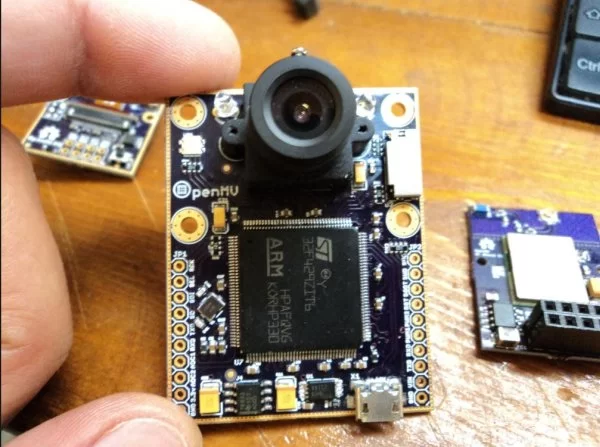Description

OpenMV cameras are programmable in Python3 and come with an extensive set of image processing functions such as face detection, keypoints descriptors, color tracking, QR and Bar codes decoding, AprilTags, GIF and MJPEG recording and more.
Additionally, OpenMV includes a cross-platform IDE (based on Qt Creator) designed specifically to support programmable cameras. The IDE allows viewing the camera’s frame buffer, accessing sensor controls, uploading scripts to the camera via serial over USB (or WiFi/BLE if available) and includes a set of image processing tools to generate tags, thresholds, keypoints etc…
The OpenMV project is a THP semifinalist and was successfully funded via Kickstarter back in 2015 and has come a long way since then.
Overview:
- Scriptable in Python3.
- On board uSD Card or internal Flash storage for scripts, images and video.
- RGB, YUV and JPEG Omnivision sensors (OV2640 and OV7725).
- Recording and Streaming GIF and MJPEG to SD or external WiFi shield.
- Extension Header breaks out UART, I2C, SPI, PWM, DAC and ADC.
- User-friendly Python IDE to view the framebuffer and upload scripts to the camera.
- 16MB SDRAM on-board enables uClinux to run on OpenMV2.
- Image processing library includes:
- Line, circle, rectangle detection.
- Face detection with VJ (compatible with OpenCV’s cascades)
- ORB keypoints detector, descriptor, matching and tracking.
- QR and Bar codes decoding and AprilTags support.
- Template matching with Normalized Cross Correlation (NCC)
- Misc functions: kmeans, filters, scaling, sub-image, blitting and alpha blending.
The Hardware:
- Processor: Based on STM32F ARM Cortex-M Digital Signal Controllers (DSCs) running at 168-216MHz. Features a single precision FPU, DSP instructions and a DCMI (Digital Camera Interface). The low-cost, the HW camera interface and the FPU and DSP made this particular controller a perfect match for the project.
- Image Sensor: OpenMV1 supports many single package lens/sensors, such as the OV965x and OV2640 while OpenMV2 and OpenMV3 support a single sensor with an external lens.
- PCB: Although it costs more, a 4-layer PCB is used for all cameras for better signal integrity and EMI issues. Additionally, using 4-layers made it possible to fit everything on the 1.0×1.3 inches OpenMV1 board. The first PCB prototypes were all ordered from OSHPark.
- Debugging and Flashing Firmware: The Serial Wire Debugging (SWD) is broken out on all cameras for debugging with GDB and the DFU is easily accessible to upload new firmware images via USB. Additionally, the camera includes a bootloader that can be used from the IDE to easily upload new firmware images.
- I/O Headers and Shields: The main 2.54mm headers break out SPI, I2C, USART, PWM, CAN, DAC and ADC. These headers allow interfacing extension boards (or Shields) to OpenMV to extend its capabilities. For example, using SPI LCD with OpenMV camera to view the framebuffer:
Read more: OpenMV- Machine Vision for Beginners

